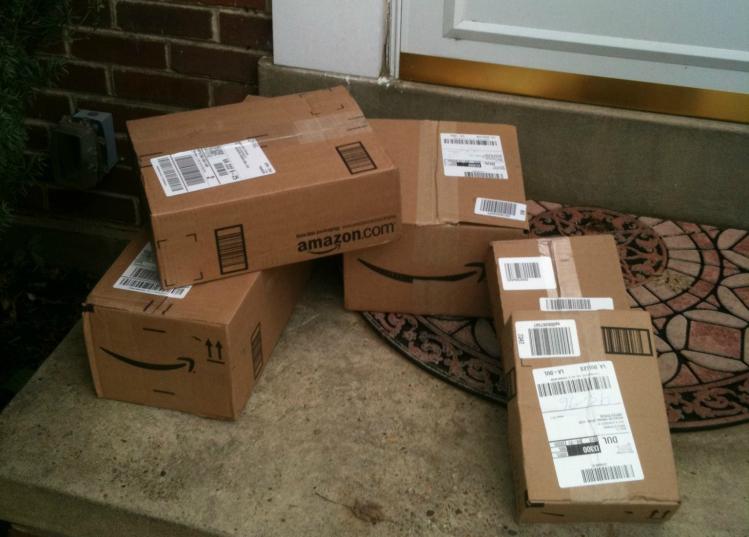
I am about to buy a butter dish. Our previous butter dish shattered in fragments on the kitchen floor yesterday. Our new one will be like the last one—plain white, oblong, utterly generic, and as cheap as I can get it.
And as easy as I can get it. Do you know what that means? Hint: name of mighty South American river.
If I were to use a brick-and-mortar store, I’d get in my car and drive two towns over to Bed Bath & Beyond, an errand of maybe an hour. Fifteen years ago that wouldn’t have bothered me, because I’d have had no option. But options alter our decisional logic. Why spend that hour chasing a butter dish when I can spend it getting work done—paid work—or emailing friends, or making inroads on an ever-daunting pile of household repairs? Life is short, time is money: such maxims frame that hour’s errand as a waste of time and recommend the convenient thing instead. Grab mouse, click, we’re done.
The topic, then, is convenience, and where it takes us—most often, these days, to the mighty river of Amazon. I’m going to gather my courage and assay the totality of my family’s commerce on the mighty river. It’s easy—of course!—to do this: just click on the “orders” tab. And voilà, fifty-seven orders by the Coopers in the last six months. Our purchases range from the practical to the fanciful: inkjet cartridges; shoe heel lifts (to even out my uneven legs); a pet gate; winter gloves; a pasta-making machine; a vacuum cleaner and replacement bags; a silicon keyboard cover for our daughter’s laptop; a 2018 calendar datebook; winter boots for her; an “I Love Bulldogs” tee shirt; the complete Jonny Quest video collection; a six-pack of Tiptree of London brown sauce; a vapor lamp, digital laser thermometer gun, and other items relating to our recent acquisition of a pet tortoise. And a whole slew of books and CDs. The total six-month Cooper outlay in Bezos-land? $1,472.
The prevalence of books among our purchases highlights the fact, now all but forgotten, that Amazon started as a bookstore. Back then, investors who threw money at the company, despite year after year of its failing to turn a profit, clearly saw what was coming—that it would eventually morph into an everything store; that Amazon’s future lay not in bringing this or that good to market, but rather in becoming the market. From the individual consumer’s point of view, the capstone innovation in accomplishing this dominance was Amazon Prime. For an annual fee, Prime offers all sorts of premium services—including streaming videos and original programming, which my family uses hardly or not at all, though plenty of other people do.
Yet two of those premium services are crucial: simplified, no-cost returns; and two-day delivery. These seemingly innocuous policies have proved to be game-changers, taking convenience to a whole new level. Online purchasing, in which you can’t touch or try on anything, inevitably incurs a higher proportion of returns than onsite purchasing; and the chore of packaging, addressing, and paying for those returns proved a stumbling block for many. Amazon Prime took care of that: you reuse the package the item came in; you zap out a mailing label on your printer; and you send the thing back—for free. Removing these nagging impediments smoothed the purchasing process, a major uptick in convenience.
But the second innovation—two-day delivery—is the subtler and more insidious one. To grasp its power, you have to view a commercial transaction not merely as a rational economic event, but a psychological one. There turns out to be big difference between buying something you expect to come in about ten days, and buying something you know will be here the day after tomorrow. It’s all about the delay. Online retailers have grasped that any undue pause between our readiness to buy and the arrival of the purchase exerts a dampening effect on consumer ardor. Amazon Prime removes that awkward emptio interrupta, allowing the consumer to proceed quickly from arousal to consummation. That excitement feeds back into the transactional loop and ramps up the willingness to buy. Convenience, in other words, not only caters to instant gratification, but provokes it. What results is the kind of Amazon order list I disclosed above. Replicated in millions of households across the country, that list tolls the death knell for physical stores. Think of how many places I would have visited to track down all that stuff. The transformative effect of digital commerce has taken a while to register, but what’s upon us is a tsunami of brick-and-mortar closures. If I were to drive out to that Bed, Bath & Beyond, I’d pass the Sears that has closed (200,000 jobs and $26 billion in market value lost in a decade), the Toys R Us that is about to close (200 stores, 30,000 jobs), and any number of other enterprises, once thought impervious, that are now endangered—gods of retail brought to their knees by online trade. Of course, other businesses may well move into those locations. Amazon itself, meanwhile, has generated a lot of new jobs—warehouse jobs, not retail jobs, but jobs all the same. Change is the rule of modern life, a constant churn driven by globalization, technological transformation, and the relentless concentration of retail business in ever-larger and more remote corporate entities.
Understanding the macroeconomic implications is beyond my pay grade. But as a matter of daily lived life, the transformative power of convenience and cost—saving time and saving money—are clear. You find yourself torn between your priorities as a consumer and your values as a citizen and a person. Here are two personal examples of such conflicts.
1) For years I used a framing shop near our neighborhood. A family business for decades, it was run by a fifty-something guy named Bruce and his grown daughter. The store occupied a single, shotgun-style room, crammed to the ceiling with frames; organization was haphazard, but Bruce could find anything. He addressed each project you brought to him with fastidious attentiveness—if it was an old painting or a family photo, he wanted to know its story—and he took as much time as necessary to work with you and find just the right frame and matte. “Hold on a sec,” he’d say; “there’s something I had back here that just might, just might be perfect.” He’d go digging in a corner and come back with something to try. All the while, the family’s aged golden retriever lay on a mat in the middle of the store, occasionally getting up to totter over and be stroked by a customer.
I’m guessing you’re not surprised to learn that the store closed. There’s a familiar pattern by which family-run businesses like this go under. Rents increase, driven up by competition from corporate chains with deep pockets; chain stores and e-commerce drain off business; profits gradually decline as costs rise; the death spiral is on. I was sorry to see Bruce’s place go, and all that went with it—a truly local family business. On the other hand, I’d walk out of there sometimes shaking my head at how much I had just paid. And other times I wouldn’t even go because, well, the whole process was so time consuming. I’d zip off to Michael’s, the national chain crafts store, instead. And now Bruce is gone.
2) The Indian dinner. Last week we had friends over, and I made a dish from a cookbook by the Indian food maven, Madhur Jaffrey. The preparation proved more arduous than expected, involving not one but two spice mixes—both of which had to be measured out, then pan-roasted, then ground up in my coffee grinder, then mixed with moistening ingredients, and finally introduced into the dish at different stages as it cooked. The result was terrific, and our guests loved it. And yet... we have a superb Indian grocery six blocks from our house, and there you can buy prepared spice packets for a wide range of Indian dishes. These are pre-roasted, pre-ground, pre-moistened spice mixes; all you do is open, combine with some yogurt, and presto. The result is 90 percent as good as the dish I labored for two hours to prepare. Cheaper, too. So what do I do the next time?
In such situations there’s a critical point beyond which the time-effort-money-gulping route simply becomes too onerous, and you just cave in to convenience. I’m aware that in choosing to float lazily down Amazon I am contributing to processes whose consequences in some ways I lament. A writer friend recently blasted me for buying books from Amazon—an evil force in the book trade, in her view, using its might to dictate publishing decisions, drive down prices, and impoverish writers. But what are my options? It has been fifteen years since we had a real bookstore in town. That store was run by two imperious and eccentric sisters, one of whom once threw me out for whistling. (“What do you think this is,” she scolded me, “your shower?”) After that, it was Borders or Barnes & Noble. But were they really that much better than Amazon?
Writing in the New York Times recently, Columbia law professor Tim Wu called convenience “the most underestimated and least understood force in the world today.” Acknowledging its powerful seductiveness, Wu points out that convenience “has a complex relationship with other ideals that we hold dear.” The fundamental attraction is the promise of relief from work. But do we really want to be liberated from all work? Wu asks. “Perhaps our humanity is sometimes expressed in inconvenient actions and time-consuming pursuits.” And yet, in the implacable way of all technology, devices of convenience not only reconfigure our daily routines, but transform us in the process.
As task after task becomes easier, the growing expectation of convenience exerts a pressure on everything else to be easy or get left behind. We are spoiled by immediacy and become annoyed by tasks that remain at the old level of effort and time.
Wu concedes that contemporary American life offers options on a scale unimaginable to prior generations. “But being a person,” he notes, “is only partly about having and exercising choices. It is also about how we face up to situations that are thrust upon us, about overcoming worthy challenges and finishing difficult tasks—the struggles that help make us who we are.” What happens to human experience when difficulties, obstacles, and challenges are stripped out of it? Wu closes with a trenchant metaphor.
Today’s cult of convenience fails to acknowledge that difficulty is a constitutive feature of human experience. Convenience is all destination and no journey. But climbing a mountain is different from taking the tram to the top, even if you end up at the same place. We are becoming people who care mainly or only about outcomes. We are at risk of making most of our life experiences a series of trolley rides.
What to do? It’s not possible to be a neo-Luddite across the board, at least not without essentially abandoning a contemporary way of life. In which areas of your life are you willing to wall yourself off from the imperatives—and benefits—of convenience? For me, one huge area is writing. There—less perhaps by choice than by training and aptitude—I live a “slow” way of life, working and reworking an essay or story or review, sentence by sentence, until I get it as right as I possibly can. As I told an editor just this morning (while begging for a higher fee), “What can I say? I'm not a fast writer. I’m an artisanal prose producer.”
So you pick your battles. “We need to consciously embrace the inconvenient,” Wu writes, “not always, but more of the time.” I agree—I’d say I wholeheartedly agree, but I’m afraid that’s not possible. Now, if you will excuse me, I’m going to click off on this column, click onto the river, and send a butter dish floating my family’s way.
Please email comments to [email protected] and join the conversation on our Facebook page.
Share
Previous Story
Pope Francis’s ‘Gaudete et Exsultate’
Next Story
There Are Also Women There

